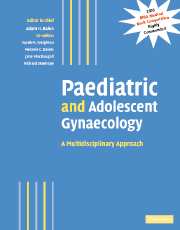Book contents
- Frontmatter
- Contents
- Contributors
- Preface
- Part I Normal development
- Part II Management of developmental abnormalities of the genital tract
- Part III Management of specific disorders
- 18 Disorders of growth and puberty
- 19 Turner's syndrome
- 20 Androgen insensitivity syndromes
- 21 Rokitansky syndrome and other Müllerian anomalies
- 22 The XY female
- 23 The gynaecology of the major genitourinary anomalies
- 24 Congenital adrenal hyperplasia
- 25 Long-term sequelae of genital surgery
- 26 Amenorrhoea
- 27 The polycystic ovary syndrome and adolescent women
- 28 Menstrual disorders in adolescent girls
- 29 Pelvic pain, ovarian cysts and endometriosis in adolescent girls
- 30 Premature ovarian failure and ovarian ageing
- 31 Gynaecological cancers in childhood
- 32 Late reproductive sequelae of treatment for childhood cancer
- 33 Preservation of fertility before cancer therapy
- 34 The management of infertility with surrogacy and egg donation
- 35 Dermatological conditions of the female genitalia
- 36 Vaginal discharge
- 37 Psychological gender development in individuals born with ambiguous genitalia
- 38 Eating disorders in adolescence
- 39 Nutritional amenorrhoea: long-term sequelae
- 40 How to set up a service: how to teach and train
- Index
- Plate section
- References
37 - Psychological gender development in individuals born with ambiguous genitalia
from Part III - Management of specific disorders
Published online by Cambridge University Press: 04 May 2010
- Frontmatter
- Contents
- Contributors
- Preface
- Part I Normal development
- Part II Management of developmental abnormalities of the genital tract
- Part III Management of specific disorders
- 18 Disorders of growth and puberty
- 19 Turner's syndrome
- 20 Androgen insensitivity syndromes
- 21 Rokitansky syndrome and other Müllerian anomalies
- 22 The XY female
- 23 The gynaecology of the major genitourinary anomalies
- 24 Congenital adrenal hyperplasia
- 25 Long-term sequelae of genital surgery
- 26 Amenorrhoea
- 27 The polycystic ovary syndrome and adolescent women
- 28 Menstrual disorders in adolescent girls
- 29 Pelvic pain, ovarian cysts and endometriosis in adolescent girls
- 30 Premature ovarian failure and ovarian ageing
- 31 Gynaecological cancers in childhood
- 32 Late reproductive sequelae of treatment for childhood cancer
- 33 Preservation of fertility before cancer therapy
- 34 The management of infertility with surrogacy and egg donation
- 35 Dermatological conditions of the female genitalia
- 36 Vaginal discharge
- 37 Psychological gender development in individuals born with ambiguous genitalia
- 38 Eating disorders in adolescence
- 39 Nutritional amenorrhoea: long-term sequelae
- 40 How to set up a service: how to teach and train
- Index
- Plate section
- References
Summary
Introduction
Gonadal hormones play an important role in sexual differentiation of the external genitalia. In addition, in nonhuman mammals, gonadal hormones have profound influences on brain development; consequently, alterations in levels of these hormones during critical periods of prenatal or neonatal development exert permanent influences on behaviour. This suggests that children born with ambiguous genitalia might also experience hormone-induced changes in behaviour, particularly in regard to behaviours related to sex. This chapter reviews what is known about psychosexual development in individuals born with intersex conditions or otherwise exposed during early development to unusual hormone environments.
Causes of genital ambiguity
The most common cause of genital ambiguity is the genetic disorder congenital adrenal hyperplasia (CAH) in XX individuals. Females with CAH are born with partially to completely virilized genitalia, caused by prenatal exposure to excess androgen from the adrenal glands. Other causes of genital ambiguity include:
androgen insensitivity syndrome (AIS) in XY infants (in the complete form of AIS (CAIS) the genitalia appear to be essentially female at birth because of complete inability of cells to respond to androgen; in partial AIS (PAIS) the genitalia are typically ambiguous, because the cells show some ability to respond to androgen)
disorders in XY individuals involving enzymes needed to produce hormones in the androgen pathway (e.g. deficiency of 5α-reductase or of 17β-hydroxysteroid dehydrogenase); both deficiencies result in genitalia that look more like those of females than males at birth but which virilize at puberty.
maternal ingestion, during pregnancy, of hormones that stimulate or block receptors for gonadal steroids (the genitalia of exposed females are often virilized to some degree, although this is not always the case, depending on the hormone prescribed and the time period during which it was taken).
- Type
- Chapter
- Information
- Paediatric and Adolescent GynaecologyA Multidisciplinary Approach, pp. 492 - 508Publisher: Cambridge University PressPrint publication year: 2004



